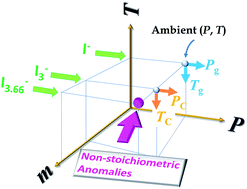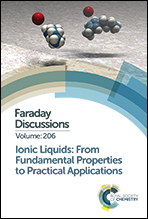Low-temperature and high-pressure phases of a room-temperature ionic liquid and polyiodides: 1-methyl-3-propylimidazolium iodide
Abstract
Using simultaneous small-angle X-ray scattering (SAXS) combined with differential scanning calorimetry (DSC) and wide-angle X-ray scattering (WAXS) combined with DSC measurements, low-temperature (LT) solid phases of a room-temperature ionic liquid (RTIL) and its mixtures were examined at ambient pressure. The considered RTIL was 1-methyl-3-propylimidazolium iodide ([C3mim][I]), and the mixtures could be expressed as [C3mim][Im]. Under high-pressure (HP), the crystallization of pure [C3mim][I] was suppressed, as a LT-amorphous form of pure [C3mim][I] was formed. In the mixed system, the HP crystallization of [C3mim][I3] occurred at 0.95 GPa of compression. In [C3mim][I3.66] as a non-stoichiometric system, complicated phase changes were observed. Upon compression, the edge of a sample container was crystallized. By further compression, a crystal–crystal phase transition was observed as a HP-crystal polymorph appeared. In the centre, HP amorphization was observed upon compression, whereas decompression crystallization was induced by decreasing the pressure. The HP complicated behaviors of non-stoichiometric [C3mim][I3.66] are caused by the excess of iodide/iodine.

- This article is part of the themed collection: Ionic liquids: from fundamental properties to practical applications


 Please wait while we load your content...
Please wait while we load your content...